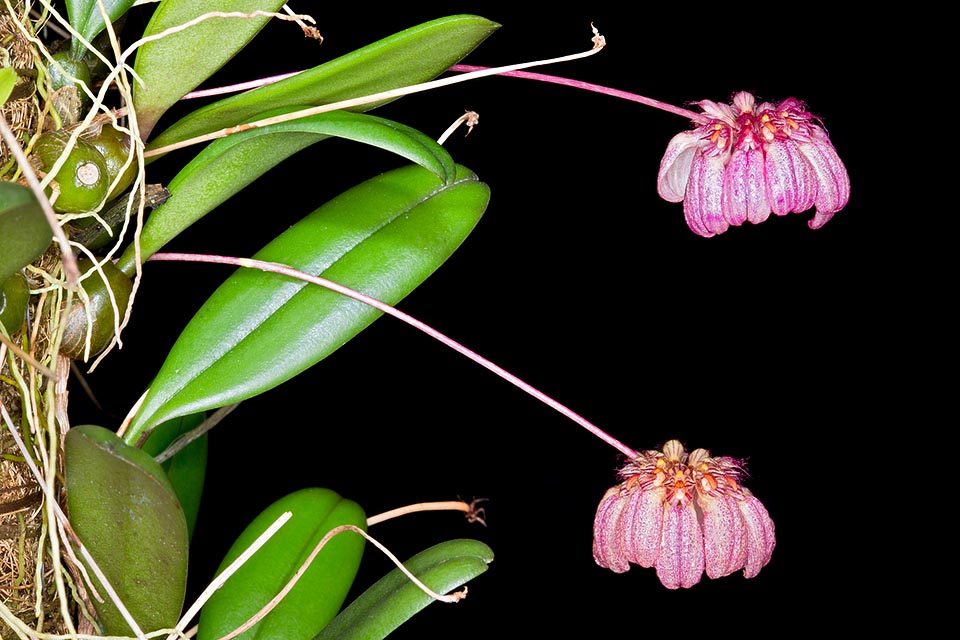Family : Orchidaceae

Text © Pietro Puccio

English translation by Mario Beltramini

The Bulbophyllum auratum is a Borneo, Eastern Himalaya, Malaysia, Sumatra and Thailand epiphytic species of the humid forests at low and medium altitudes. 1-3 cm long, oblong pseudobulbs, spaced of 1-2 cm on thin creeping rhizome rooting at the nodes, provided at the apex of an 8-15 cm oblong leaf with obtuse apex © G. Mazza
The species is native to Borneo, Eastern Himalaya, Malysia, Sumatra and Thailand where it grows on the trees of the humid forests at low and medium altitudes.
The name of the genus is the combination of the Greek substantives “βολβός” (bolbos) = bulb and “φύλλον” (phyllon) = leaf, with reference to the leaves growing at the apex of the pseudobulbs; the specific name is the Latin adjective “auratus, a, um” = golden, with reference to the more or less intense background colour and to the down at the margins of the dorsal sepal and of the petals.
Common names: golden bulbophyllum (English).
The Bulbophyllum auratum (Lindl.) Rchb.f. (1861) is an epiphytic species with oblong pseudobulbs, 1-3 cm long, spaced of 1-2 cm on a thin creeping rhizome rooting at the nodes and provided at the apx of an oblong leaf with obtuse apex, 8-15 cm long and 2-2,5 cm broad, thick, coriaceous, of intense green colour above, purple suffused below. Umbelliform inflorescence from the base of the pseudobulb, on a 8-15 cm long scape, bearing 8-15 tiny flowers arranged in circle of rather variable colour, usually pale yellow more or less widely dotted of purple on the lateral sepals and with streaks of the same colour on the dorsal sepal and petals; are present in nature individuals without red pigmentation. Concave ovate-elliptic dorsal sepal with pointed apex, ciliate, oblong lateral sepals merged almost up to the base, at times free at the apex, 1,5 cm long and 0,8 cm broad, ovate petals, 0,4-0,5 cm long, ciliate, curved oblong labellum, 0,3-0,4 cm long, fleshy. It reproduces by seed, in vitro, and by division, with each section provided of at least 3-4 pseudobulbs, at the vegetative restart.

Umbelliform inflorescence seen from below and from side. It starts from the base of pseudobulb, on an 8-15 cm long scape, with 8-15 tiny flowers arranged in circle of variable colour, usually pale yellow more or less widely dotted of purple on the lateral sepals and with streaks of the same colour on the dorsal sepal and the petals © Giuseppe Mazza
Strong species, floriferous and of easy cultivation requires semi-shaded position, medium-high temperatures in summer, 22-32 °C, slightly cooler in winter, with lowest night ones not under the 14 °C, high humidity, 80-85%, and constant ventilation. Mounted on trunks, bark or rafts of cork or of arborescent ferns roots, requires frequent waterings and nebulizations utilizing rain water, demineralized or by reverse osmosis at ambient temperature. Cultivated in pots or baskets with aerated and draining compost, formed for instance by medium sized bark and charcoal fragments, with possible addition of sphagnum, the waterings must be more spaced, allowing the substratum to partially dry up before giving water again. Fertilizations every two weeks from spring to autumn, monthly in winter, utilizing a balanced hydrosoluble product, with microelements, at ¼ of the dosage suggested by the producer. Transplants and repottings are to be done, when strictly necessary, at the vegetative restart marked by the emission of the new roots.
The species is reported in the appendix II of CITES (species whose trade is internationally ruled).
Synonyms: Cirrhopetalum auratum Lindl. (1840); Phyllorchis aurata (Lindl.) Kuntze (1891); Phyllorkis aurata (Lindl.) Kuntze (1891); Cirrhopetalum borneense Schltr. (1906); Bulbophyllum auratum (Lindl.) Ridl. (1907); Bulbophyllum campanulatum Rolfe (1909); Cirrhopetalum campanulatum (Rolfe) Rolfe (1910); Bulbophyllum borneense (Schltr.) J.J.Sm. (1912).
